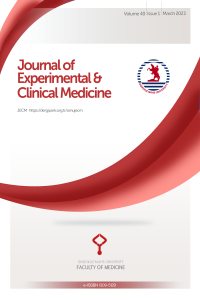Abstract
References
- Masrul M. The obesity epidemic and its impact on public health status and the nation’s socioeconomic status. Andalas Med Mag. 2018;41(3):152.
- McArdle MA, Finucane OM, Connaughton RM, McMorrow AM, Roche HM. Mechanisms of obesity-induced inflammation and insulin resistance: Insights into the emerging role of nutritional strategies. Front Endocrinol (Lausanne). 2013;4(MAY):1–23.
- Biobaku F, Ghanim H, Monte S V., Caruana JA, Dandona P. Bariatric surgery: Remission of inflammation, cardiometabolic benefits, and common adverse effects. J Endocr Soc. 2020;4(9):1–17.
- Di Nicola V. Omentum a powerful biological source in regenerative surgery. Regen Ther. 2019;11:182–91.
- Meza-Perez S, Randall TD. Immunological Functions of the Omentum. Trends Immunol. 2017;38(7):526–36.
- PJ A, K S, Ignacimuthu S, N AA-D. High Fat Diet-Fed, Streptozotocin-Induced Diabetic Rat Model: Is It an Ideal Type 2 Diabetic Model? J Endocrinol Diabetes Res. 2017;3(1).
- Sithole HL. A review of the use of Streptozotocin ( STZ ) in the induction of diabetes in rats and subsequent ocular tissue changes. 2009;68(2):82–8.
- Ghasemi A, Khalifi S, Jedi S. Streptozotocin-nicotinamide-induced rat model of type 2 diabetes (review). Acta Physiol Hung. 2014;101(4):408–20.
- Vieira R, Souto SB, Sánchez-López E, Machado AL, Severino P, Jose S, et al. Sugar-lowering drugs for type 2 diabetes mellitus and metabolic syndrome—strategies for in vivo administration: Part-II. J Clin Med. 2019;8(9):1–20.
- Drucker DJ. The Cardiovascular Biology of Glucagon-like Peptide-1. Cell Metab. 2016;24(1):15–30.
HOMA-IR level in obese type 2 diabetic rat model treated by Sleeve gastrectomy and pancreatic omentoplasty
Abstract
Obesity is a health problem that occurs due to the wrong lifestyle, such as lack of physical activity and the wrong diet. Accumulation of adipose tissue in obesity may increases pro-inflammatory cytokines, particularly in pancreatic beta cells leading to type 2 diabetes mellitus (T2DM). Sleeve gastrectomy (SG) is an alternative therapy for T2DM in obese patients by losing about 40-60% of body weight and increasing GLP-1 secretion which stimulates increased insulin secretion. However, the SG procedure cannot reduce pro-inflammatory cytokines which promote damaged pancreatic cells. Pancreatic omentoplasty can suppress pro-inflammatory cytokines and promote the regeneration of damaged pancreatic cells. The goal of this study is to investigate HOMA-IR in obese rats with diabetes mellitus who underwent SG and pancreatic omentoplasty procedures. An experimental using pre and post-test control group design were done in this study. Eighteen Diabetes Mellitus rats were divided into 3 groups: K1 (SG), K2 (SG + Omentoplasty), and K3 (control). Blood glucose and insulin level were measured using a glucoDR Glucometer Bio-sensor kit and ELISA, respectively before and 10 days after the procedure. HOMA-IR measurement was calculated based on insulin and blood glucose level. A significant decrease of fasting blood gluocese levels were shown in all treatment groups of this study after day 10th. There was a significant increase in the insulin levels after day 10th. Highest decrease of the blood glucose levels and increase of the insulin levels were shown in group K2. Furthermore, a significant decrease of HOMA-IR was shown in the K2 on day 10th. From this study, we may conclude that SG and Pancreas Omentoplasty may significantly reduce the HOMA-IR value in obese rats with T2DM.
Supporting Institution
Diponegoro University Semarang, Indonesia
References
- Masrul M. The obesity epidemic and its impact on public health status and the nation’s socioeconomic status. Andalas Med Mag. 2018;41(3):152.
- McArdle MA, Finucane OM, Connaughton RM, McMorrow AM, Roche HM. Mechanisms of obesity-induced inflammation and insulin resistance: Insights into the emerging role of nutritional strategies. Front Endocrinol (Lausanne). 2013;4(MAY):1–23.
- Biobaku F, Ghanim H, Monte S V., Caruana JA, Dandona P. Bariatric surgery: Remission of inflammation, cardiometabolic benefits, and common adverse effects. J Endocr Soc. 2020;4(9):1–17.
- Di Nicola V. Omentum a powerful biological source in regenerative surgery. Regen Ther. 2019;11:182–91.
- Meza-Perez S, Randall TD. Immunological Functions of the Omentum. Trends Immunol. 2017;38(7):526–36.
- PJ A, K S, Ignacimuthu S, N AA-D. High Fat Diet-Fed, Streptozotocin-Induced Diabetic Rat Model: Is It an Ideal Type 2 Diabetic Model? J Endocrinol Diabetes Res. 2017;3(1).
- Sithole HL. A review of the use of Streptozotocin ( STZ ) in the induction of diabetes in rats and subsequent ocular tissue changes. 2009;68(2):82–8.
- Ghasemi A, Khalifi S, Jedi S. Streptozotocin-nicotinamide-induced rat model of type 2 diabetes (review). Acta Physiol Hung. 2014;101(4):408–20.
- Vieira R, Souto SB, Sánchez-López E, Machado AL, Severino P, Jose S, et al. Sugar-lowering drugs for type 2 diabetes mellitus and metabolic syndrome—strategies for in vivo administration: Part-II. J Clin Med. 2019;8(9):1–20.
- Drucker DJ. The Cardiovascular Biology of Glucagon-like Peptide-1. Cell Metab. 2016;24(1):15–30.
Details
| Primary Language | English |
|---|---|
| Subjects | Health Care Administration |
| Journal Section | Research Article |
| Authors | |
| Early Pub Date | March 18, 2023 |
| Publication Date | March 18, 2023 |
| Submission Date | September 4, 2022 |
| Acceptance Date | November 26, 2022 |
| Published in Issue | Year 2023 Volume: 40 Issue: 1 |
Cite

This work is licensed under a Creative Commons Attribution-NonCommercial 4.0 International License.


